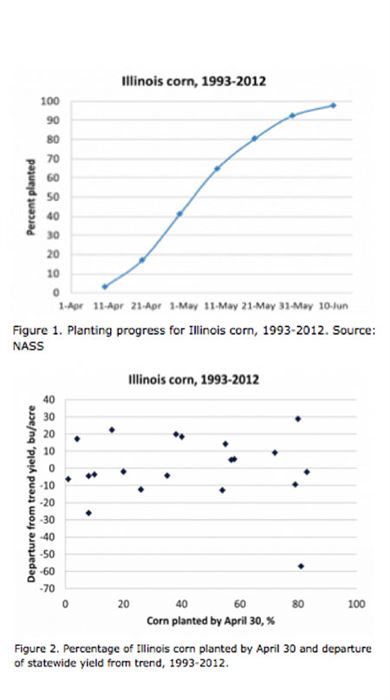Planting Delays And Corn Prospects
URBANA, ILL.
April 2013 has turned into
a “second March”, with
wet weather and cool
temperatures persisting into
the last week of the month,
and corn planting progress
stuck at 1 percent, with little
chance of much additional
progress before the calendar
turns to May. Nationally, only 4 percent of the
corn crop was planted by April 21, and none of
the Corn Belt states had more than 1 percent
planted. The corn that has been planted is
struggling mightily to
survive the soil conditions
and to emerge.
If we are lucky enough
to “skip” another month
and have May look more
like a typical June, it’s
not too late to get the
planting and crop back
on track. So while yield
potential will start to
drop as we get farther
into May with planting,
chances of a good corn
crop remain high, as
long as weather permits
planting soon, and then
returns to a more normal
pattern of rainfall
without summer
drought periods like
we’ve had the past three
years in parts of Illinois.
Most of our planting
date studies show that
yield loss accelerates as
planting is delayed in
May, and getting corn
planted by the end of
April is a recognized goal
in Illinois. The reality is,
though, that on average,
we have only managed to
get a little more than 40
percent of our corn
planted by this target
date (Figure 1), and it’s
nearly the end of May
before we get to 90 percent
planted. We have
several times in recent
years planted more than
50 percent of the corn
crop in a 10-day period,
and have the capacity to
plant much faster than
that if all fields were
ready at once. This
means that weather and
soil conditions are the
barriers to planting
early.
Despite our anxiousness
to finish planting by the end of April, Illinois
data over the past 20 years do not show
that early planting alone boosts yields. In fact,
there is no correlation between time to 50%
planted and yield, as measured by departure
from trendline yield (Figure 2). It’s clear that the
early planting and drought-damaged yields of
2012 helped wreck this correlation, but even if
we eliminate 2012, percent planted by April 30
still explains only about 5 percent of the yield
departure from trend.

Does this mean that getting the crop planted
early is not important as a management goal?
Certainly not: planting before the end of April
generally means that we’ve removed late planting
– and the shortened season and greater
chance of stress that follow late planting – as a
potential barrier to high yields, thus maximizing
yield potential. At the same time, we need to
recognize that it’s not “game over” if we are
forced by weather and soil conditions to plant
into May, even past mid-May.
The fact that early planting does not necessarily
lead to high yields does tell us that what
happens after planting and through the rest of
the season is more important than when we get
the crop planted. This in turn reminds us that
it’s important not to do anything that might
compromise the plant’s ability to take advantage
of conditions later in the season that will
determine actual yield. That certainly includes
taking care not to plant into wet, compacted
soils in our rush to plant early. Δ
DR. EMERSON NAFZIGER: Professor/Research
Education Center Coordinator, University of Illinois